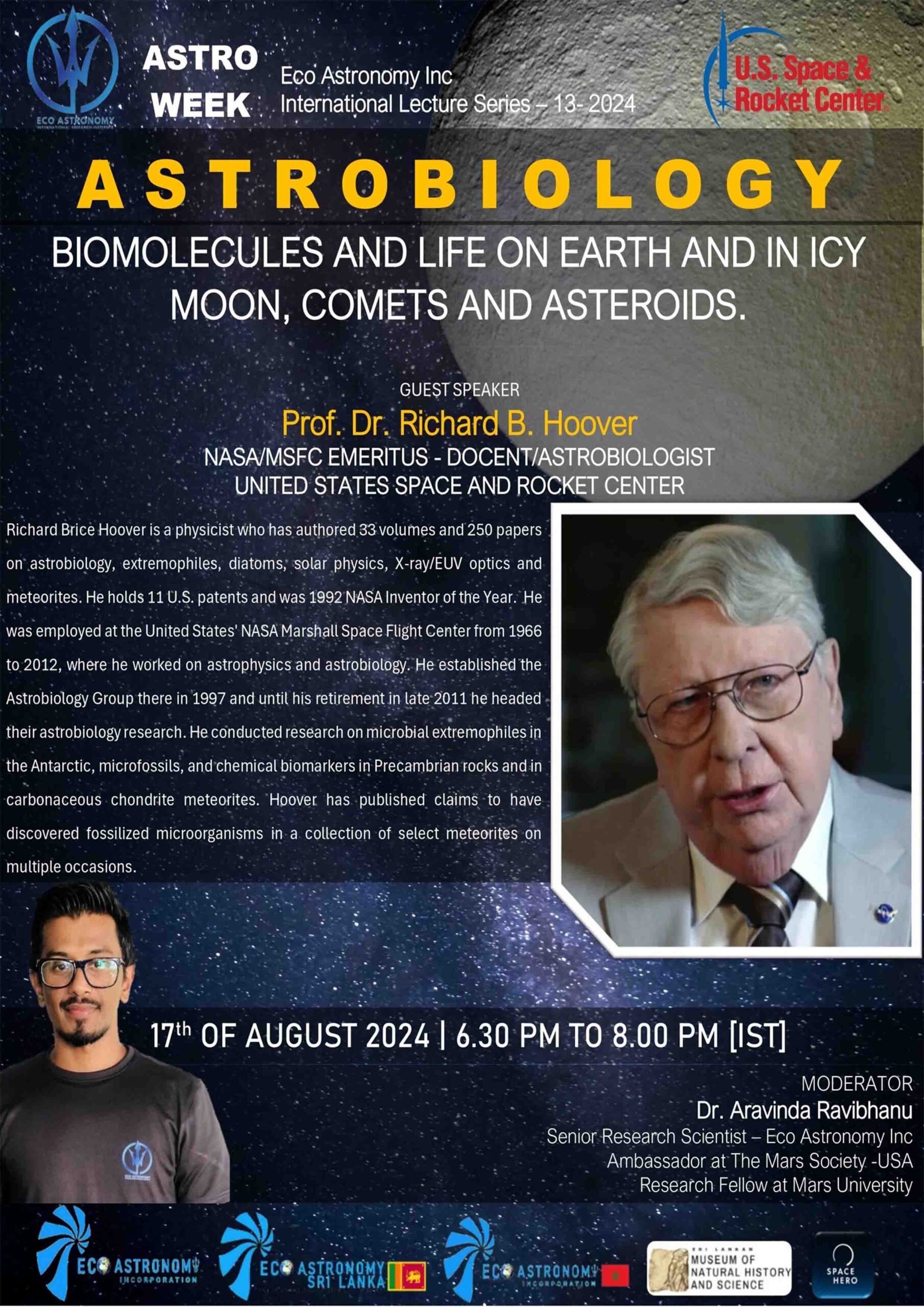ASTROBIOLOGY : BIOMOLECULES AND LIFE ON EARTH AND IN ICY MOONs, COMETS AND ASTEROIDS

Guest Speaker : Prof. Dr. Richard B. Hoover [ NASA – National Aeronautics and Space Administration /MSFC EMERITUS – DOCENT/ASTROBIOLOGIST| UNITED STATES SPACE AND ROCKET CENTER]
Prof. Dr. Richard B. Hoover left his teaching post at the University of Arkansas in 1966 to join the von Braun team at the NASA Marshall Space Flight Center in Huntsville, Alabama. He developed diffraction limited telescopes and Laser Ranging RetroReflectors (LRRR) for tracking the Apollo Saturn V moon rockets. The LRRR arrays were deployed on the moon by the Apollo 11, 14 and 15 astronauts. They are the only lunar experiments that continue working. The LRRR experiment continues to deliver precise data on lunar orbital parameters of value to future moon missions and direct relevance to General Relativity and String theories. He served as Co-Investigator for the SKYLAB Apollo Telescope Mount S-056 Experiment. He was Principal Investigator for the Multi-Spectral Solar Telescope Array (MSSTA) Observatory that produced simultaneous soft x-ray/EUV images of the Solar Photosphere, Chromosphere and Corona using his advanced multilayer telescopes. He analyzed the solar data and published papers on coronal loops, plumes and x-ray bright points. He patented numerous novel x-ray telescopes, microscopes, collimators and spectrometers and was named the 1992 NASA Inventor of the Year for the Water Window Imaging X-ray Microscope.
In 1986, Dr. Hoover collaborated with Sir Fred Hoyle in a study that revealed a close correspondence of the measured infrared properties of diatoms and the infrared spectrum of interstellar dust as observed in the Trapezium nebula and toward the Galactic Center source GC IRS-7. They advanced the hypothesis that diatoms and similar microbial life forms might inhabit and be spewed into space from oceans of icy moons Enceladus or Europa and from aqueous cavities or pools just beneath the dark crusts of comets as they are heated near perihelion. This research resulted in his selection in 1997 to establish the Astrobiology Research Group at NASA/MSFC. He produced and published high resolution SEM images of cyanobacteria and diatoms in the Polonnaruwa, Orgueil, Murchison and other carbonaceous meteorites that are thought to be the remains of extinct comets. EDS data proves these remains are ancient, indigenous and extraterrestrial rather than modern biological contaminants. Prof. Hoover organized and led scientific expeditions to many of the most hostile environments on Earth. He explored ice caves and discovered microbial life in Deep Ice Cores from just above Lake Vostok in Antarctica. He discovered mosses and described new species of bacteria that were still alive after being frozen in ancient permafrost of Alaska and the far northeast regions of Siberia. He was elected Fellow National of the Explorers Club in recognition of his work leading scientific expeditions to Antarctica, Siberia, Alaska, South Africa, Patagonia and exploring ice caves in Iceland, Canada and high in the Austrian Alps. Samples collected during these expeditions resulted in discovery and valid publication of 1 new Family; 6 Genera and 15 species of extremophilic bacteria and archaea previously unknown to Science.
Professor Dr. Richard B. Hoover has Authored/Edited over 50 Books and over 400 scientific papers on X-ray Optics, Solar Physics, Diatoms, Bacteria, Microfossils and Meteorites. His Scientific Expeditions and research are featured in films produced by the History Channel, Fox News, NBC Lx, Ancient Aliens, The Science Channel, NASA’s Unexplained Files, NHK Japan Television, National Science Foundation: “Science Nation: Extremophiles”, BBC, Discovery Channel and National Geographic. Prof. Dr. Richard B. Hoover was awarded the Degree and Title: Doctor of Sciences, Honoris Causa, Russian Academy of Sciences in 2021 by Academician Prof. Dr. Alexander M. Sergeev, President of the Russian Academy of Sciences. In 2023, he was Awarded the Degree and Title: Professor Doctor Ilia State University, Tbilisi, Georgia and elected Fellow of the World Academy of Art and Science (WAAS).
MODERATOR : Aravinda Ravibhanu | Ambassador at Beijing Forestry University International College | China | Ambassador at The
